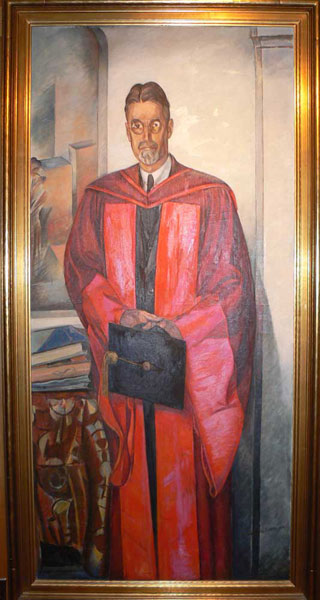Next story: Beyond the LIterate Rock Laureate Shell of Okkervil River
The Vorticist & Chancellor
by Dean Brownrout
Wyndham Lewis (1882-1957) was an important and controversial English modernist painter and writer. He founded the short-lived Vorticist movement, an artistic style which grew out of Cubism and Futurism. Vorticism is considered to be one of the most noteworthy contributions by Britain to art of the early 20th century.

Intellectual poet Ezra Pound coined the name Vorticism, and this fantastic word referenced the contrast between movement and stillness represented by the style. The Vorticists published a literary journal called BLAST (1914-15). Lewis was the editor, and Pound and T.S. Eliot contributed. The magazine also influenced progressive typography and design movements of the time.
Chancellor Samuel Capen (1939), an important painting by Lewis, resides in the Poetry Collection of the State University of New York at Buffalo. It generally hangs in the corridor of their library. Right now, the piece (along with a Lewis self-portrait also held by the Poetry Collection) is on view at Britain’s National Portrait Gallery.
The London show, titled Wyndham Lewis: Portraits, is the most important retrospective on the artist since his passing. Also being shown are Lewis’ portraits of his astoundingly important and influential contemporaries Pound, Eliot, Virginia Woolf, and James Joyce.
In 1932, noted British impressionist painter Walter Sickert called Lewis “the greatest portraitist of this or any other time.” In 1939, Lewis came to North America, uncertain of his ability to earn a living in the UK during wartime. That same year, Thomas B. Lockwood, a Buffalo lawyer, businessman, and significant benefactor of the University of Buffalo (now SUNY at Buffalo), commissioned him to paint a portrait of Samuel Capen, the university’s first full-time chancellor.
The portrait would turn out to be Lewis’ only “official” commissioned one ever. While Lewis and Capen got along well, conflict arose when Lewis refused to exhibit the portrait at the Albright Art Gallery (now the Albright-Knox Art Gallery). In so doing, he alienated members of Buffalo’s social and cultural hierarchy.
The Cubist elements in the Capen portrait are a startling contrast to what is expected of a conventional portrait commission. In fact, Lewis struggled with, in his words, “trying to make it as academic as possible and still keep it a work of art.”
Author’s note: James Maynard (Visiting Assistant Curator, the Poetry Collection, State University of New York at Buffalo) and the Poetry Collection archives were invaluable sources for this article. The library possesses one of the largest collections of Wyndham Lewis’ papers, documents, and manuscripts in the world.
blog comments powered by Disqus|
Issue Navigation> Issue Index > v7n41: Trans-Evolution (10/9/08) > The Vorticist & Chancellor This Week's Issue • Artvoice Daily • Artvoice TV • Events Calendar • Classifieds |









 Current Issue
Current Issue